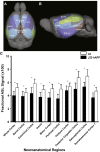Imaging of cerebrovascular pathology in animal models of Alzheimer's disease
- PMID: 24659966
- PMCID: PMC3952109
- DOI: 10.3389/fnagi.2014.00032
Imaging of cerebrovascular pathology in animal models of Alzheimer's disease
Abstract
In Alzheimer's disease (AD), vascular pathology may interact with neurodegeneration and thus aggravate cognitive decline. As the relationship between these two processes is poorly understood, research has been increasingly focused on understanding the link between cerebrovascular alterations and AD. This has at last been spurred by the engineering of transgenic animals, which display pathological features of AD and develop cerebral amyloid angiopathy to various degrees. Transgenic models are versatile for investigating the role of amyloid deposition and vascular dysfunction, and for evaluating novel therapeutic concepts. In addition, research has benefited from the development of novel imaging techniques, which are capable of characterizing vascular pathology in vivo. They provide vascular structural read-outs and have the ability to assess the functional consequences of vascular dysfunction as well as to visualize and monitor the molecular processes underlying these pathological alterations. This article focusses on recent in vivo small animal imaging studies addressing vascular aspects related to AD. With the technical advances of imaging modalities such as magnetic resonance, nuclear and microscopic imaging, molecular, functional and structural information related to vascular pathology can now be visualized in vivo in small rodents. Imaging vascular and parenchymal amyloid-β (Aβ) deposition as well as Aβ transport pathways have been shown to be useful to characterize their dynamics and to elucidate their role in the development of cerebral amyloid angiopathy and AD. Structural and functional imaging read-outs have been employed to describe the deleterious affects of Aβ on vessel morphology, hemodynamics and vascular integrity. More recent imaging studies have also addressed how inflammatory processes partake in the pathogenesis of the disease. Moreover, imaging can be pivotal in the search for novel therapies targeting the vasculature.
Keywords: Alzheimer's disease (AD); amyloid-beta (Aβ); angiography; cerebral amyloid angiopathy (CAA); cerebral blood flow (CBF); magnetic resonance imaging (MRI); microscopy; transgenic mice.
Figures











Similar articles
-
ApoA-I deficiency increases cortical amyloid deposition, cerebral amyloid angiopathy, cortical and hippocampal astrogliosis, and amyloid-associated astrocyte reactivity in APP/PS1 mice.Alzheimers Res Ther. 2019 May 13;11(1):44. doi: 10.1186/s13195-019-0497-9. Alzheimers Res Ther. 2019. PMID: 31084613 Free PMC article.
-
A1 reactive astrocytes and a loss of TREM2 are associated with an early stage of pathology in a mouse model of cerebral amyloid angiopathy.J Neuroinflammation. 2020 Jul 25;17(1):223. doi: 10.1186/s12974-020-01900-7. J Neuroinflammation. 2020. PMID: 32711525 Free PMC article.
-
Noninvasive magnetic resonance imaging detection of cerebral amyloid angiopathy-related microvascular alterations using superparamagnetic iron oxide particles in APP transgenic mouse models of Alzheimer's disease: application to passive Abeta immunotherapy.J Neurosci. 2011 Jan 19;31(3):1023-31. doi: 10.1523/JNEUROSCI.4936-10.2011. J Neurosci. 2011. PMID: 21248127 Free PMC article.
-
Endothelial Mitochondrial Dysfunction in Cerebral Amyloid Angiopathy and Alzheimer's Disease.J Alzheimers Dis. 2019;72(4):1019-1039. doi: 10.3233/JAD-190357. J Alzheimers Dis. 2019. PMID: 31306129 Free PMC article. Review.
-
Cerebral amyloid angiopathy: emerging concepts.J Stroke. 2015 Jan;17(1):17-30. doi: 10.5853/jos.2015.17.1.17. Epub 2015 Jan 30. J Stroke. 2015. PMID: 25692104 Free PMC article. Review.
Cited by
-
Tranexamic acid in a mouse model of cerebral amyloid angiopathy: setting the stage for a novel stroke treatment approach.Res Pract Thromb Haemost. 2023 Aug 9;7(6):102166. doi: 10.1016/j.rpth.2023.102166. eCollection 2023 Aug. Res Pract Thromb Haemost. 2023. PMID: 37694270 Free PMC article.
-
Studies for Improving a Rat Model of Alzheimer's Disease: Icv Administration of Well-Characterized β-Amyloid 1-42 Oligomers Induce Dysfunction in Spatial Memory.Molecules. 2017 Nov 18;22(11):2007. doi: 10.3390/molecules22112007. Molecules. 2017. PMID: 29156571 Free PMC article.
-
The β-secretase (BACE) inhibitor NB-360 in preclinical models: From amyloid-β reduction to downstream disease-relevant effects.Br J Pharmacol. 2019 Sep;176(18):3435-3446. doi: 10.1111/bph.14582. Epub 2019 Mar 10. Br J Pharmacol. 2019. PMID: 30657591 Free PMC article. Review.
-
Advancing Cardiovascular, Neurovascular, and Renal Magnetic Resonance Imaging in Small Rodents Using Cryogenic Radiofrequency Coil Technology.Front Pharmacol. 2015 Nov 12;6:255. doi: 10.3389/fphar.2015.00255. eCollection 2015. Front Pharmacol. 2015. PMID: 26617515 Free PMC article. Review.
-
Endothelial Nitric Oxide Synthase-Deficient Mice: A Model of Spontaneous Cerebral Small-Vessel Disease.Am J Pathol. 2021 Nov;191(11):1932-1945. doi: 10.1016/j.ajpath.2021.02.022. Epub 2021 Mar 10. Am J Pathol. 2021. PMID: 33711310 Free PMC article. Review.
References
Publication types
LinkOut - more resources
Full Text Sources
Other Literature Sources
Research Materials

